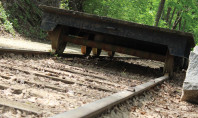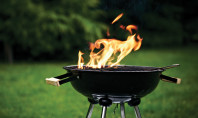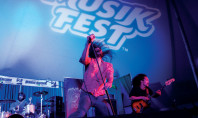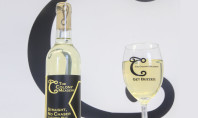Martin Guitar
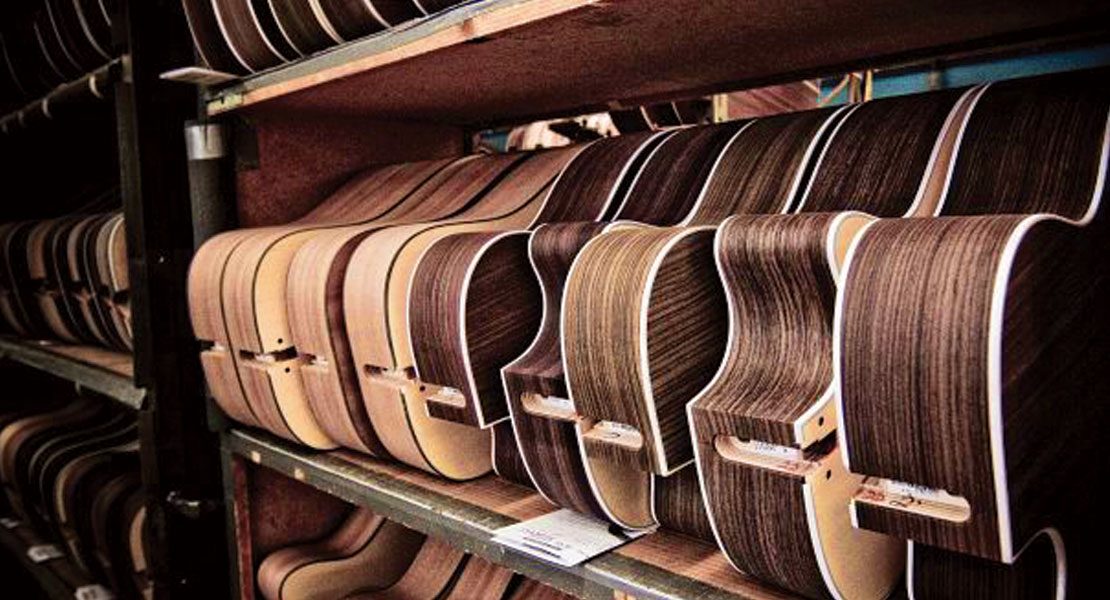
by Liz Reph
Celebrated throughout the world for its top-quality instruments, C. F. Martin & Company has been headquartered in Nazareth for the past 175 years. Although they are best known for guitars – which have been famously played by performers such as Eric Clapton, Joan Baez, Johnny Cash, Elvis Presley, Kurt Cobain, Willie Nelson, Bob Dylan, Eddie Vedder and Woody Guthrie – Martin & Co. has a long history crafting a variety of stringed instruments.
C. F. Martin is a family-run company currently in its sixth generation. Its founder, Christian Frederick Martin (the original “C. F.”), was born to a long line of cabinetmakers and woodworkers in Germany in 1796. At age fifteen he was apprenticed to a renowned guitar maker in Vienna, where he learned the skills of the trade that would shape his family’s future.
In late 1833, seeking opportunities beyond what his native land could offer, Martin, his young wife and children immigrated to the United States. Settling in New York City, he established C. F. Martin & Company and, by early 1834, had opened a shop at 196 Hudson Street in the Lower West Side of Manhattan.
Since the guitar industry was still in its infancy (and thus the market rather limited), Martin sold his handcrafted instruments out of his own shop and through various distribution agreements with music teachers, importers and wholesalers. To supplement his income, he also operated his shop as a full-scale music store – peddling everything from trombones, trumpets, and harps to sheet music, strings and other accessories.
“Martin on Main”
On Saturday, August 2nd the annual “Martin on Main” event will take place in historic downtown Nazareth. Celebrate the rich history and music of Martin Guitars while enjoying three stages of live entertainment, assorted crafts, artisans and local food, beer and wine. Attendees are encouraged to bring their own guitar and participate in jam sessions.
But while Martin’s business steadily grew, he and his wife never fully embraced the fast-paced city atmosphere. So, when Martin’s longtime friend and business associate, Henry Schatz, purchased a large tract of land in Pennsylvania near the town of Nazareth, Martin’s wife took the opportunity to visit. Upon seeing the town, she immediately fell in love with Nazareth’s gentle rolling hills and rural landscapes – all of which reminded her of their native Europe.
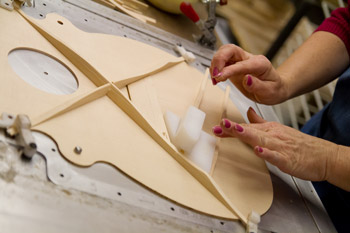 At his wife’s urging, Martin sold his store’s inventory and moved his family and company from New York to Nazareth. Purchasing an eight-acre lot near the road between Nazareth and Wind Gap, he set up his new headquarters in the spring of 1839.
At his wife’s urging, Martin sold his store’s inventory and moved his family and company from New York to Nazareth. Purchasing an eight-acre lot near the road between Nazareth and Wind Gap, he set up his new headquarters in the spring of 1839.
In Nazareth, Martin began to delve more deeply into developing different styles and variations for his guitars. Throughout the 1840s and 50s he experimented with shape, ornamentation and, perhaps most importantly, bracing – the system of wooden struts that internally supports the guitar’s soundboard and back. It was during this time that Martin developed the “X” bracing system. Still used in all steel-string Martin guitars today, “X” bracing is credited for creating the signature “Martin tone” of “brilliant treble” and “powerful bass response.”
Throughout the 1840s and 50s, sales of Martin guitars took off as well. The company’s shipping records frequently mention large transactions in cities such as Philadelphia, Nashville, St. Louis, Boston, Cincinnati and New Orleans. To keep pace with the increased demand, Martin & Co. moved its factory to a larger facility on the corner of Main and North Street, next to the Martin family home, in 1859.
In February of 1873, founder C. F. Martin passed away at age 77. His son, 48-year-old Christian Frederick Martin, Jr., took over as company president. The Junior Martin’s tenure was short-lived, however, as he died unexpectedly in 1888 – leaving the company to his inexperienced 22-year-old son, Frank Henry Martin. At the time Frank Henry took over, Martin & Co. was engaged in an exclusive distribution agreement with the New York based sales agency C. A. Zoebisch & Sons. The agreement essentially put Zoebisch in the position of running Martin & Co., as the sales agency dictated what and how much the company produced. For the young Martin, this situation posed two major problems: Firstly, Zoebisch’s primary business was distributing band and orchestral instruments, and so consequentially Martin felt his guitars were not given sufficient advertising. Secondly, during the early 1890s a massive influx of Italian immigrants created a large demand for mandolins. Seeing this as an excellent opportunity to expand business, Martin became committed to producing the instrument, while Zoebisch resisted.
These disagreements ultimately led to Frank Henry Martin making the difficult – and risky – decision to terminate the company’s distribution agreement. In 1898, he changed the brand on his instruments from “C. F. Martin & Co., New York” to “C. F. Martin & Co., Nazareth” and started selling guitars and mandolins directly out of the Nazareth factory. By launching various advertising and direct mail campaigns, while also personally embarking on rigorous sales trips throughout the Northeast, Martin’s decision ultimately paid dividends. Within just a few short years, guitars sales reached more than 200 per year, while annual mandolin sales hit approximately 100 – a significant growth for the company.
In the early 1920s, the sudden popularity of another instrument – the ukulele – also drastically impacted Martin & Co. Originating in Hawaii, the ukulele gained fame in mainland America as a staple of the Jazz Age. The demand was so great that, in order to accommodate production, a large wing was built onto the North Street facility, doubling the factory’s size. In 1920 alone, it is estimated that Martin & Co. produced over 2,000 ukuleles, plus another 1,300 guitars. Although the ukulele “boom” was short lived, the prosperity it brought helped the company weather the immense hardships of the Great Depression, which began in 1929.
Like most companies, Martin & Co. was drastically affected by the Depression. Between 1929 and 1931, guitar sales plummeted to half of what they had been only a few years earlier. To keep employees busy, Martin & Co. diversified its production line to include violin parts, and even briefly experimented with producing wooden jewelry out of scraps of rosewood. In an attempt to stimulate sagging guitar sales, Frank Henry Martin also began an aggressive product development campaign. Although most of his innovations were short lived, two major developments – the introduction of the large Dreadnought guitar and the creation of the 14-fret neck – would remain staples of the Martin line. The 14-fret neck would even go on to become the standard in the American guitar industry.
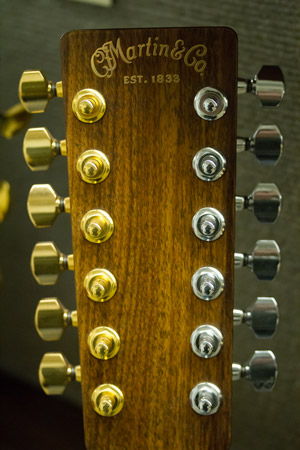 The company’s next major shift came following the end of World War II in 1945. After Frank Henry Martin passed away in 1948, his son, C. F. Martin III, took over. At this time, the popularity of folk music, and, with it, guitars, rose steeply. So great was the demand for Martin guitars that by the early 1960s Martin & Co. was backordered up to three years!
The company’s next major shift came following the end of World War II in 1945. After Frank Henry Martin passed away in 1948, his son, C. F. Martin III, took over. At this time, the popularity of folk music, and, with it, guitars, rose steeply. So great was the demand for Martin guitars that by the early 1960s Martin & Co. was backordered up to three years!
But because the North Street factory was limited in both space and layout (being several stories tall, the building forced workers to carry guitar parts up and down narrow steps – a time-consuming and potentially dangerous practice), C. F. Martin III and his son, Frank H. Martin, decided to once again move locations. In 1964 Martin & Co. moved into its current factory, a large, single-floored facility on Sycamore Street in Upper Nazareth. With a better layout and workflow, this new factory allowed the company to increase personnel, and thus production. As a result, between 1963 and 1974, total sales for Martin & Co. increased from $900,000 per year to more than $10
million per year.
In the wake of this prosperity, Frank H. Martin led Martin & Co. through an era of acquisitions, purchasing smaller companies such as the Vega Banjo Works, Fibes Drum Company, Darco String Company and the A. B. Carlson Levin Company (makers of classic guitars and steel strings) during the 1970s. While the majority of these subsidiaries were eventually resold in the 1990s, Darco Strings still remains an integral part of the company.
Today, Christian Frederick Martin IV, the great-great-great-grandson of founder C. F. Martin, serves as company chairman and CEO. Under his leadership, Martin & Co. built its one-millionth guitar in 2004, and continues to lead the world in crafting high-quality instruments.





